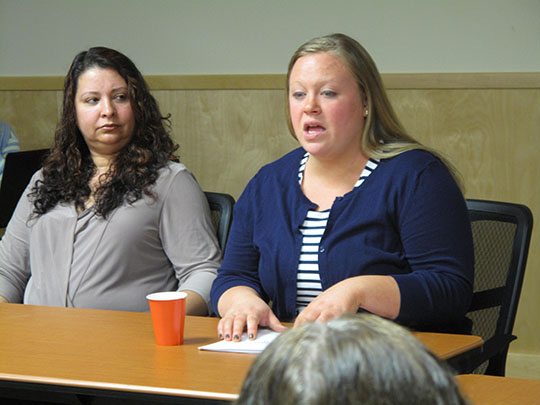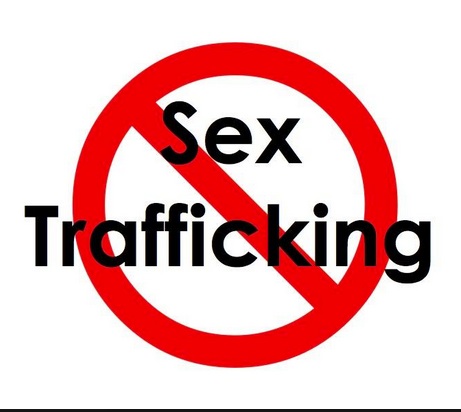To introduce the program on sex trafficking and its ramifications locally, a short film, Chosen, depicted how traffickers target and recruit young people into the sex trade. The film followed the experiences of two teenage girls stalked and preyed upon by sex traffickers. Briana, an 18 year old student athlete with high career goals who was targeted by a “cool older guy” while waitressing, ended up in a strip club being “shopped around” to other pimps; she only escaped because her ex-boyfriend Evan and her parents were able to stage an intervention with a counselor that helped her see she was being trafficked.
Similarly, Lacy, only 13, “fell in love” with a 23-year old man she “met” at a party, ended up participating in stripping, being raped, beaten, and coerced into prostitution. Her pimp kept her in line with physical abuse and threats to show the video of her being raped to her family and friends.
Traffickers (often attractive, “cool,” older men) target and manipulate vulnerable teenagers; once entrapped girls don’t feel they can return home safely.
Chosen stressed the importance of getting “the word out” so young people will be able to protect themselves. Traffickers lurk “where kids hang out”: malls, Starbucks, arcades, parks, restaurants. Danger signs include an older boyfriend a girl is secretive about, expensive clothes or gifts, a tattoo of someone’s name.
Friends and family can help: 1) Know what human trafficking is, 2) Know the signs someone is being stalked, 3) Don’t be afraid to tell, and 4) Take action now.
After a break for refreshments and conversation, Liz Spence began the second portion of the program by noting that (shocked as we may be) Syracuse is a hub of sex trafficking. She introduced our expert speakers. Erin Yeager is the Sexually Exploited Youth Specialist at McMahon/Ryan Child Advocacy Center, a nonprofit agency whose mission is ending child abuse through intervention and education. Her agency works closely with the Onondaga County Child Task Force, social services, and Safe Harbor Initiative (which she and McMahon/Ryan represent).

Elisa Morales does volunteer work with victims and actively lobbies for social justice and human rights legislation. She is a NYS New Abolitionist and spokesperson for the Central New York Anti-Trafficking Coalition.
Erin Yeager said that the McMahon/Ryan Center is co-located with a police unit, Child Protective Services, and a medical clinic. Every family gets an advocate. Exploited youth include girls, boys, LGBT; sex trafficking does not discriminate. Traffickers can be male pimps, female madams, or parents who exploit their children for drugs, money, or blackmail. Erin and Elisa each spoke about her involvement in combating sex trafficking. Erin Yeager said that the McMahon/Ryan Center is co-located with a police unit, Child Protective Services, and a medical clinic. Every family gets an advocate. Exploited youth include girls, boys, LGBT; sex trafficking does not discriminate. Traffickers can be male pimps, female madams, or parents who exploit their children for drugs, money, or blackmail.
The Safe Harbor Initiative (passed in 2008) changed the language of the law so that children younger than 18 involved in prostitution will be treated as abuse victims rather than arrested as criminals. This shift makes it easier for victims to feel comfortable coming forward. The state allocated moneys for cities with high sex trafficking; unbelievably to some of us, Syracuse is the #1 city for sex trafficking in New York State. While sex trafficking seems to be exploding, Erin hopes that some of the rise may be because people are getting smarter and bringing cases forward.
People ask: why don’t victims of sexual abuse just leave? Victims generally don’t speak out; they are very well trained by their abusers. They may be “branded” by their owner (just like a cattle brand). They may fear for their safety or their family’s safety. The pimp may hold their passports and threaten them with deportation if they don’t comply.
Elisa Morales, who as a victim of sexual violence spent much of her life “in silence,” now travels through the state and country helping others escape abuse. Although she has been threatened in the course of her volunteer work, she has committed her life to this cause.
New York is the fourth busiest trafficking state, behind Texas, California, and Florida. In this area it is not uncommon for parents to sell sex with their child in exchange for rent. Syracuse is involved in Internet bidding wars for virgins; human beings are the merchandise for sale. The New York State Fair is one of the busiest times for sex trafficking. Elisa has seen an increase in males being victimized in our area.
Drugs are often involved. Traffickers have monetary incentives: porn is a huge industry generating LOTS of money. Elisa was instrumental in lobbying for the recently passed NYS Trafficking Victims Protection and Justice Act, which includes more accountability for sex traffickers and more services for victims so they will not be re-victimized by the system. Elisa urged us all to become involved and send a letter to our legislator thanking him/her for passing this law.
Elisa closed with a story about a client of hers from Thailand who had been horrifically abused there and then “sold forward.” One day while walking in Destiny USA with her trafficker, a passing stranger smiled at her. She “felt human” for the first time and was able to act to escape and change her life. While most of the people Elisa tried to help weren’t able to escape at that time, many will find the strength knowing supports are available and they are not “invisible.”
A lively, extended question and answer period followed. Sample questions:
How do you get a 16 year old who is protecting her trafficker to testify? Elisa usually doesn’t get involved in prosecutions unless law enforcement is involved. When she crosses paths with a victim, she quickly assesses the situation and develops a safety plan that makes sense to the victim and gives her/him tools that may utilized in captivity and/or during transit to get help. Erin’s message is that there is help and hope. If they agree, Erin tries to get them into a shelter and on the path to a better life. Most of the victims will not leave at that time, but this does not deter her from trying to help them. Although Erin may not see these victims again, she sometimes finds out, even years after meeting them, that they used the tools she gave them and chose to get help.
Erin said kids may choose this path because they are being brainwashed; they sometimes challenge her with questions such as “Well, how much money do you make in a week?” She tries to reach them with compassion and patience.
Other than the court system, how do clients come to you? Law enforcement and Child Protective Services (sex abuse) agencies located in her building may ask Erin to be an advocate if they get a suspicious case. Many victims are on PINS [Persons in Need of Supervision] or in the juvenile justice system. Law enforcement will call Elisa’s cell phone when they are “busting a ring” if they feel that hooking a victim up with an advocate will build trust (so the victim will testify.)
Kompalya Charles, who had just returned from three years in Thailand working on human trafficking issues, stressed that each female or boy enslaved in the sex trade is still a “being of light” and prayers are needed: prayers for the victims who want to leave and those who don’t and also prayers for the men who need to be reeducated.

